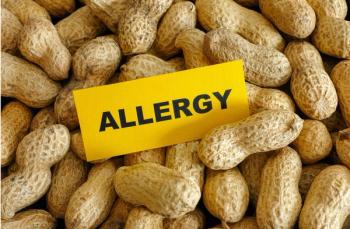
ASCO: Oxaliplatin Therapy Lengthens Overall Colon Cancer Survival
CHICAGO -- Oxaliplatin (Eloxatin)-containing chemotherapy boosts overall survival for stage III colon cancer, with a hint of benefit for high-risk stage II disease as well, according to large randomized trial.
CHICAGO, June 4 -- Oxaliplatin (Eloxatin)-containing chemotherapy boosts overall survival for stage III colon cancer, with a hint of benefit for high-risk stage II disease as well, according to large randomized trial.
Stage III patients had 4.4% better six-year overall survival (73.0% versus 68.6%) with FOLFOX4 (oxaliplatin, 5-fluorouracil, leucovorin) than with 5-fluorouracil and leucovorin alone (P=0.029), reported Aimery de Gramont, M.D., of Hpital Saint-Antoine in Paris, and colleagues, at the American Society of Clinical Oncology meeting here.
High-risk stage II patients tended to have better disease-free and overall survival with oxaliplatin as well in five- and six-year follow-up of the MOSAIC (Multicenter International Study of Oxaliplatin/5-fluorouracil/Leucovorin in the Adjuvant Treatment of Colon Cancer) trial.
"I will walk out of this room with a reinforcement of prescribing FOLFOX both in stage III and in stage II patients at high risk," said Alberto Sobrero, M.D., of the Hospital San Marino in Genoa, Italy, who was a discussant on the study.
The multinational trial included 2,246 adults with completely resected colon cancer who were chemotherapy nave. They were randomized to LV5FU2 or FOLFOX4 chemotherapy.
LV5FU2 consisted of 200 mg/m2 leucovorin (Wellcovorin) infusion for two hours followed by 5-fluorouracil (Adrucil) 400 mg/m2 bolus, then an 800 mg/m2 infusion over 22 hours for two days every two weeks.
FOLFOX4 included the same regimen but added an 85 mg/m2 infusion of oxaliplatin over two hours on day one.
Sixty percent had stage III colon cancer; 40% had stage II colon cancer.
The primary endpoint was disease-free survival, where disease was defined as relapse, second primary colon cancer, or death of any cause.
At five years in the intent-to-treat population, disease-free survival was 5.9% longer with the FOLFOX4 regimen (73.3% versus 67.4%, P=0.003), he said, as previously reported in the New England Journal of Medicine in 2004.
For stage III patients the difference was 7.5% (P=0.005) and for stage II patients it was 3.8% (P=0.258)
In an exploratory analysis, the 576 high-risk stage II patients had almost the same advantage from FOLFOX4 as stage III patients.
High risk in this group was defined as grade T4, tumor perforation, bowel obstruction, a poorly differentiated tumor, venous invasion or more than 10 lymph nodes examined.
The difference in disease-free survival for high-risk stage II colon cancer patients at five years was 7.2% (82.1% versus 74.9%) though it was not significant (hazard ratio 0.74, 95% confidence interval 0.52 to 1.06).
But, low-risk stage II disease did not gain from the addition of oxaliplatin. Five-year disease-free survival was actually lower with FOLFOX4 (86.3% versus 89.1%, HR 1.22).
At six years, overall stage II survival tended to be better with FOLFOX4 as well with a small 2.6% difference (78.6% versus 76.0%, P=0.057).
Stage III patients accounted for most of the advantage with a 4.4% higher survival probability with FOLFOX4 than with LV5FU2 (73.0% versus 68.6%, P=0.029) while stage II patients overall had no benefit (86.9% versus 86.8%, P=0.996).
Again, there was a suggestion that high-risk stage II patients benefited in overall survival with FOLFOX4, but the confidence intervals were wide and the hazard ratio was only about 0.94.
As previously published in the NEJM paper, grade III neuropathy was a significant problem with FOLFOX4, with 12.4% of patients having this versus none of those in the LV5FU2 group.
Of the 811 evaluable patients at four years, 0.7% had grade III peripheral sensory neuropathy and 2.8% had grade II.
"Substantial neurotoxicity is still important," Dr. Sobrero said. "It doesn't seem to decrease substantially."
Physicians and patients thus have to weigh the benefit and risk carefully, he added.
Dr. de Gramont concluded, "these results will support the use of FOLFOX4 as adjuvant therapy in patients with stage III," said.
"FOLFOX cannot be recommended in the low-risk stage II patients," he said, but added, "there will still be a debate for the high-risk stage II patients until we are better able to recognize this population."
However, Dr. Sobrero came to a slightly different conclusion.
"Is it worth it?" he asked. "Well, up until yesterday we did not know what patients thought about what is worthwhile."
But, he cited a study presented here at ASCO by Neil Love, M.D., of Research to Practice in Miami, that found an answer.
Among 150 patients surveyed, one-third said adjuvant chemotherapy would be worthwhile if it yielded a 1% absolute reduction in recurrent and two-thirds said a 5% reduction would be sufficient.
Based on these criteria, stage III and high-risk stage II patients would likely go for FOLFOX4 over LV5FU2, Dr. Sobrero said.
"The key issue will be reducing toxicity," he said. Possibilities for this may be to reduce the duration of therapy or to use neuroprotective agents, he said.
Newsletter
Enhance your clinical practice with the Patient Care newsletter, offering the latest evidence-based guidelines, diagnostic insights, and treatment strategies for primary care physicians.
















































































































































































































































































